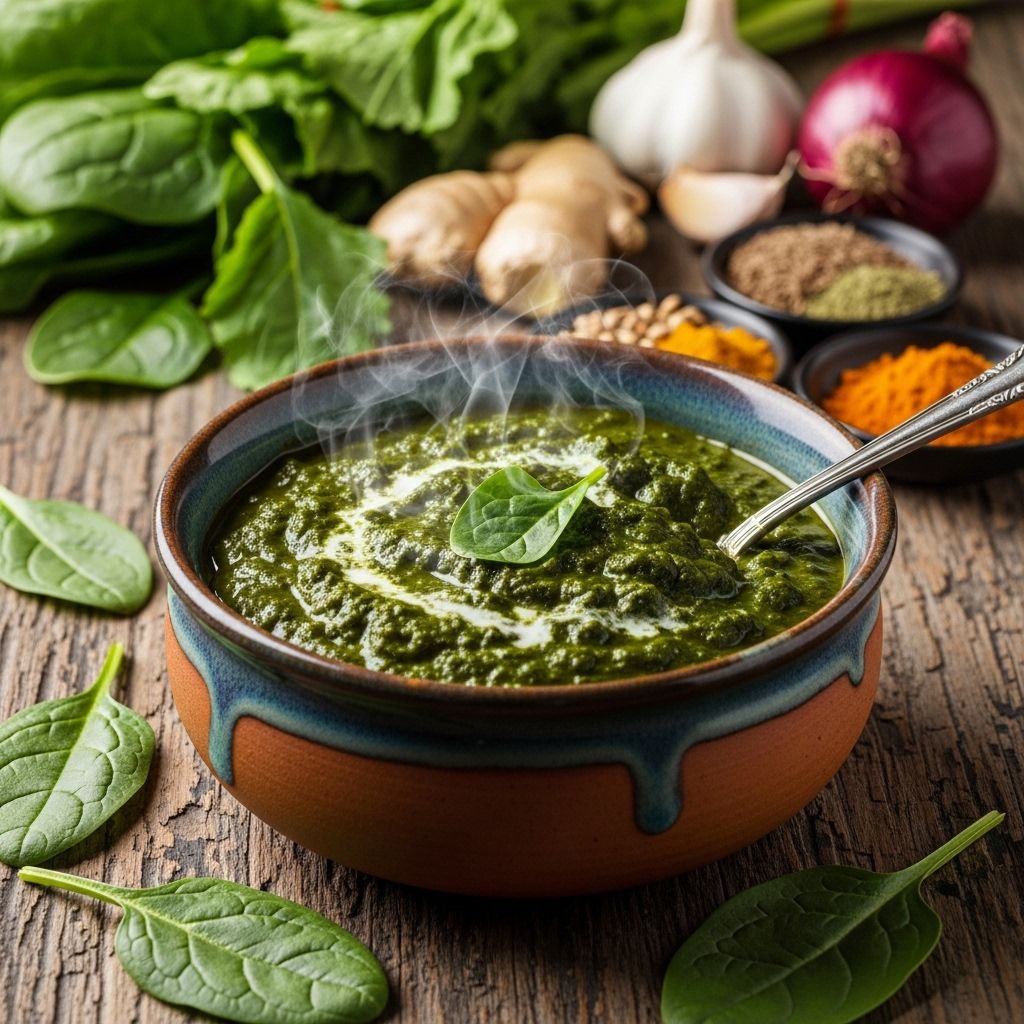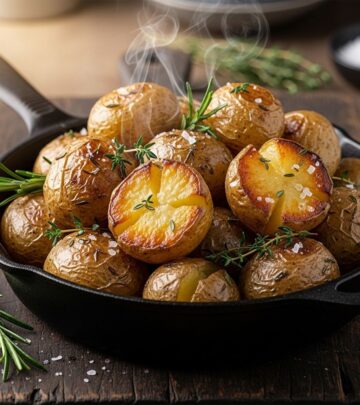Indian Saag Recipe: 5-Step Guide To Authentic Leafy Green Curry
Explore the flavors, techniques, and cultural roots of Indian saag—a hearty leafy green curry enjoyed across India.

Image: HearthJunction Design Team
Indian Saag: The Heart of Leafy Green Curries
Indian saag is a comforting, thick curry brimming with earthy greens such as spinach and mustard leaves, delicately spiced and often finished with rich butter or ghee. Rooted in tradition and packed with nutrition, saag is a staple across many Indian homes—enjoyed with naan, roti, or rice. In this comprehensive guide, you’ll find everything you need to master authentic Indian saag: an easy-to-follow recipe, essential tips, popular variations, nutrition information, and frequently asked questions.
What Is Saag?
“Saag” broadly refers to any dish made with cooked leafy greens. Variants feature greens like spinach, mustard greens, fenugreek (methi), and collard greens, often cooked together for a depth of flavor. Saag forms the base for numerous regional dishes across India—from sarson ka saag in the north to palak saag in other parts of the country.
- Common leafy greens used: spinach, mustard greens, collard greens, turnip greens, fenugreek leaves
- Can be vegetarian, vegan, or feature additions like paneer (cheese) or even chicken
- Typically thickened with besan (chickpea flour) or cornmeal for a hearty texture
Ingredients for Classic Indian Saag
To make an authentic Indian saag, gather the following ingredients. This combination balances the earthy essence of greens with aromatic spices and a creamy finish.
- 2 bunches fresh mustard greens, washed and chopped
- 1 bunch fresh spinach, washed and chopped
- 3 tablespoons ghee or vegetable oil
- 1 medium onion, finely chopped
- 3 cloves garlic, minced
- 2-inch piece fresh ginger, grated
- 2-3 green chilies, finely chopped (adjust to taste)
- 2 tomatoes, chopped
- 1 teaspoon cumin seeds
- 1 teaspoon ground coriander
- 1 teaspoon garam masala
- 1/2 teaspoon turmeric powder
- Salt to taste
- 2 tablespoons cornmeal or chickpea flour (besan)
- 1/4 cup heavy cream or plain yogurt (optional, for creaminess)
- 1 tablespoon butter or ghee for finishing
Step-by-Step Instructions
- Prepare the Greens:
- Thoroughly wash mustard greens and spinach under running water to remove any dirt.
- Roughly chop the greens and set aside.
- Cook the Greens:
- Bring a large pot of water to a boil. Add the chopped greens and blanch for 3–4 minutes until wilted and tender.
- Drain, then transfer greens to a bowl of ice water to lock in the bright color. Drain again.
- Pulse the greens in a blender or food processor until coarsely pureed. Set aside.
- Make the Base:
- Heat ghee or vegetable oil in a large pan over medium heat.
- Add cumin seeds and let them sizzle for a few seconds.
- Add chopped onions; sauté until translucent (about 4 minutes).
- Stir in garlic, ginger, and green chilies; cook until aromatic.
- Add chopped tomatoes and cook until soft and pulpy (about 5 minutes).
- Sprinkle in turmeric, coriander, and garam masala; cook for 1 minute to bloom the spices.
- Combine & Thicken:
- Add the pureed greens to the skillet. Mix well.
- Sprinkle in cornmeal or chickpea flour to thicken the saag. Stir to prevent lumps.
- Season with salt. Simmer uncovered for 12–15 minutes, stirring occasionally, until the saag thickens.
- If you prefer a creamy finish, add heavy cream or yogurt and stir well.
- Finish and Serve:
- Just before serving, top with a dollop of butter or ghee.
- Serve hot with Indian breads like naan, roti, or over steamed basmati rice.
Tips for Best Results
- Use fresh, seasonal greens for the most vibrant flavor and color.
- Blanching the greens helps retain color and removes any bitterness from mustard greens.
- Customize heat level by adjusting the amount and type of chilies.
- For a smoother saag, blend the greens longer; for rustic texture, leave them slightly chunky.
- Ghee adds richness, but you can swap with oil for a vegan version.
Variations of Saag
Indian saag is a versatile dish. Here are some classic variations you can try:
- Saag Paneer: Add cubes of fried paneer (Indian cheese) for a protein boost and creamy texture.
- Chicken Saag: Stir in cooked, spiced chicken pieces for a heartier meal.
- Saag Chole: Add boiled chickpeas for extra protein and substance.
- Mixed Greens: Combine spinach, mustard, fenugreek, or collard greens to create your signature blend.
- Vegan Saag: Use vegetable oil and coconut cream in place of ghee and dairy for a plant-based version.
Serving Suggestions
Saag is most often enjoyed with Indian flatbreads or over rice. Here are a few serving ideas to enhance your meal:
- Naan or Roti: Use the bread to scoop up the saag for an authentic experience.
- Jeera (Cumin) Rice: The aromatic rice balances the hearty greens.
- Papadums: Add a crispy side for texture variety.
- Pickles & Chutneys: Spicy or tangy condiments cut through the richness.
Nutrition Information
| Nutrient | Per Serving (approx.) |
|---|---|
| Calories | 170 |
| Protein | 7g |
| Fat | 10g |
| Carbohydrates | 15g |
| Fiber | 6g |
| Sodium | 310mg |
Note: Actual nutrition may vary depending on ingredients and portion size.
Frequently Asked Questions (FAQs)
Q: Can I use only spinach instead of mustard greens?
A: Yes, you can use just spinach for a milder flavor, but traditional saag often combines spinach with more robust greens like mustard for extra depth.
Q: How do I store leftover saag?
A: Store cooled saag in an airtight container in the refrigerator for up to 3 days. Reheat gently on the stovetop or in a microwave, adding a splash of water if needed to loosen the consistency.
Q: Can saag be made ahead?
A: Yes! Saag’s flavors deepen with time. Make it a day ahead and reheat before serving for even tastier results.
Q: Is saag gluten-free?
A: The basic saag recipe is naturally gluten-free. Check that your thickening agent contains no gluten—for example, use chickpea flour or certified gluten-free cornmeal.
Q: What other greens can I use?
A: Feel free to experiment with kale, turnip greens, collard greens, or even beet greens. Just adjust cooking times as needed since tougher greens may take longer to soften.
Expert Tips for Perfect Saag
- For a smoky flavor, try sautéing the finished saag with a whole dried red chili and a pinch of asafoetida (hing).
- If using frozen greens, thaw and drain thoroughly before use; squeeze out excess water for the right texture.
- Balance bitterness by adding a touch of cream, yogurt, or a squeeze of lemon at the end.
- Add paneer, tofu, chickpeas, or lentils to transform saag into a complete meal.
Why You’ll Love Homemade Saag
- Deeply flavorful from the perfect blend of spices and fresh greens.
- Nutritious, high in iron, fiber, and vitamins.
- Customizable for vegetarians, vegans, or meat eaters.
- Easy to prepare with pantry staples.
Final Thoughts
Saag is more than just a curry—it’s a celebration of seasonal greens and aromatic spices, steeped in Indian culinary tradition. Whether enjoyed alongside warm breads, rice, or paired with protein, saag offers a canvas for endless variation and comfort. Mastering this dish means you can bring a taste of India to any kitchen, any time of year.
Further Reading and Related Recipes
- Try Saag Paneer for a cheesy, protein-rich twist.
- For meat lovers, Chicken Saag blends tender chicken with creamy greens.
- Experiment with North Indian Saag Chole—greens and chickpeas in a spicy curry.
References
- https://www.allrecipes.com/recipe/64066/indian-saag/
- https://www.allrecipes.com/recipe/228957/authentic-saag-paneer/
- https://www.allrecipes.com/recipe/215021/chicken-saag/
- https://www.allrecipes.com/recipe/282061/north-indian-saag-chole-chickpeas-and-greens/
- https://www.youtube.com/watch?v=hIZDMvWQzZc
Read full bio of Anjali Sayee












